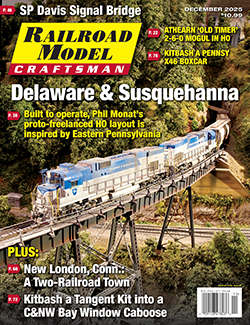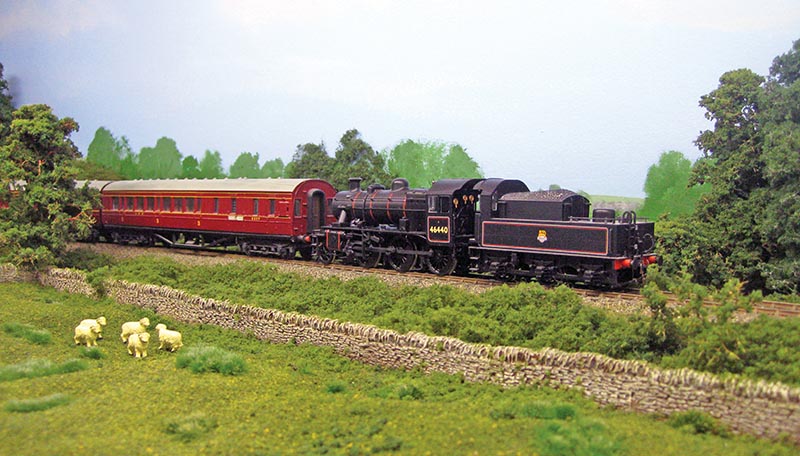 Looking for modeling inspiration that’s off the beaten path, or perhaps across the pond? Or perhaps you’re short on space, or you want a second, smaller model railroad that’s out of the ordinary, something you can easily transport to model railroad shows. Have you ever considered modeling a British prototype in 4mm/1:76 scale?
Looking for modeling inspiration that’s off the beaten path, or perhaps across the pond? Or perhaps you’re short on space, or you want a second, smaller model railroad that’s out of the ordinary, something you can easily transport to model railroad shows. Have you ever considered modeling a British prototype in 4mm/1:76 scale?
British railroading, particularly from the 1930s to the 1960s, has enraptured me since my teens. Bullhead rail, diminutive rolling stock, signal cabins with staff and token systems, and, best of all, the beautiful steam locomotives and unusual first- and second-generation diesels draw me like steel to a rare earth magnet. This led me in 2008 to build “Ettinsmoor,” an early 1950s British Railways branch line set in Cumbria, just before the dreaded “Beeching Axe” fell across its neck, eliminating numerous branch lines across the country. Occupying a “J” shape in a 12×15-room, Ettinsmoor was a typical branch line terminus served by a twice-daily passenger train, a thrice-weekly goods train (freight) serving a nearby limestone quarry, and a once-daily mixed train. Each train departed staging, worked up the line to Ettinsmoor station, and returned. Motive power was exclusively Bachmann Branchline’s well-detailed and reliable steam locomotives.
Modeling in 4mm British outline offers two significant advantages. First is compactness. Great Britain’s standard-gauge railway network is the world’s oldest, and it also has the most restrictive “loading gauge” or clearances. With some exceptions, maximum height above the rail is 13 ft. 6 in., compared to North America’s typical Plate F clearance of 17 ft. What this means is that a typical 4mm scale 0-6-0T is a tad taller than two inches, about the same as an American 3.5mm scale 0-6-0 T. Or, put another way, a British 4mm 4-6-2 placed next to a venerable Lionel “OO gauge” 4-6-4 from the 1940s would be noticeably smaller, even though they’re the same scale.
The second advantage is shorter equipment and typically shorter trains, making a small model railroad seem larger. Box vans (boxcars), up until the modern, post-BR era, measured 17 to 18 scale feet, mineral wagons just under 17 scale feet, and a Stanier corridor brake third (a third-class passenger coach introduced in 1936 with brake equipment and compartment for the “guard,” or conductor) comes in at 57 scale feet, or about nine inches long. A branch line goods train of six to eight vans and wagons, with a brake van and a ubiquitous 0-6-0T on the point, is about 36 to 40 inches long.
Speaking of branch lines, the most popular layout theme in Britain is the country branch line terminus (BLT), like my Ettinsmoor. A functional, operations-based layout can be constructed in as small as 48 by 15 inches, and I’ve seen even smaller examples. Almost all feature a fiddle yard or sector plate staging, and here again the compactness of British outline rolling stock comes into play. The internet is rife with track plans for almost all eras and locations.
There’s one disadvantage: price. The British pound is stronger than the U.S. dollar, so what would cost you $1 here will cost you $1.30 or so from a hobby shop. But don’t let that discourage you. You can find deals on auction sites, and even some U.S. retailers may offer British equipment.
I was determined to cut as few corners as possible with my Ettinsmoor layout. True, the gauge was 16.5mm (00), that weird holdover from the 1920s when motors for HO scale mechanisms were too large for British outline locomotives. I had plans to convert to EM gauge (18mm), which is much closer to true standard gauge. In the meantime, I changed out the stock hook-and-loop couplers for traditional scale three-link, Instanter, or screw-link types as appropriate to the type of rolling stock. I developed plans for a working signal system using a miniature manual interlocking box interfaced with a microcontroller. And I added etched brass details to the right-of-way, such as facing-point locks, switch-throw rodding with compensators, and other mechanical interlocking goodies. When I moved in 2018, I had to dismantle my Ettinsmoor layout, but I already have another narrow gauge version in the works.
So if you’re looking for something new, consider prototypes from Great Britain. After all, it is the birthplace of railroading.
—Paul Schmidt



